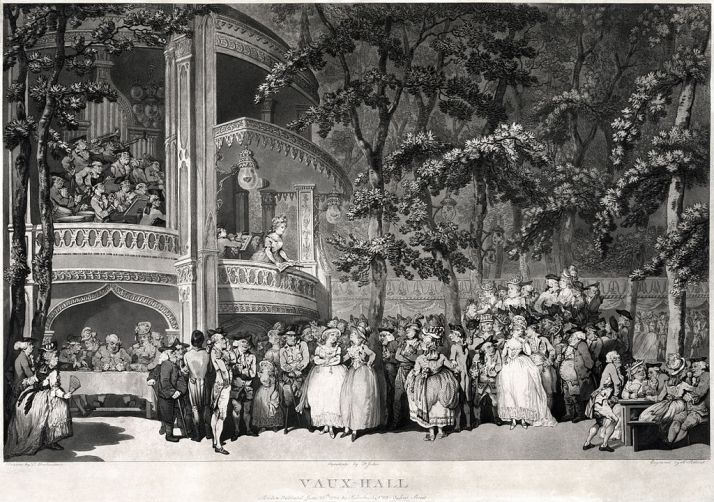Vauxhall Gardens: A History
David Coke & Alan Borg
The Vauxhall Pleasure Gardens is one of the places I’d love to slip back in time to visit, just to catch a glimpse of what it was like. After recently splurging to buy this lovely coffee-table book, I thought it might make a wonderful subject for a new blog series. But do buy the book too, if you can! The photos are fabulous!
I’m so excited! I just bought a mounted poster of this painting in color from art.com to hang in my bedroom/office here in Florida.
By the time this painting appeared, Jonathan Tyers had died and Vauxhall Gardens passed on to his wife and children, but it was his son Jonathan Tyers Jr.—that n’er-do-well younger son who wed a widowed lady much older than he and caused a giant rift among his parents—who assumed his father’s role in managing the park.
In the supper-box on the left we see, reading left to right, James Boswell, Mrs Thrale (who appears twice), Dr. Johnson, and Oliver Goldsmith.
The ‘macaroni’ Captain Edward Topham (scandalmonger to The World) is quizzing Georgiana, Duchess of Devonshire and her sister Lady Duncannon (Sheridan’s Lady Bessborough), watched by a naval figure with an eye patch and a wooden leg (not included in the Mellon version), always called Admiral Paisley, but Paisley did not lose his leg and eye until 1st June 1794, so it cannot be him. To the left of him, a young girl (a young boy in the Mellon version) holding the hand of a man who could be the comic actor, William Parsons, or Rowlandson’s friend Jack Bannister.
Peering at the two ladies from behind a tree is a figure traditionally, though improbably, identified as Sir Henry Bate-Dudley, the ‘Fighting Parson’, editor of the Morning Herald; he is more likely to be Thomas Tyers (son of Jonathan Tyers the great entrepreneur and proprietor of Vauxhall Gardens from 1729 until 1767) who stands next to the Scotsman James Perry, editor of the London Gazette. The couple on their right could well be the artist himself and his current girlfriend. and to the right of them stands the actress Mary ‘Perdita’ Robinson, with her husband on her right and the Prince of Wales (later George IV) on her left.
Looking up at the singer, the couple on the extreme left, have been identified as the actress Miss Hartley, in company with one of her many admirers, possibly Mr. Colman, but, suggested by their position apart from the crowd, they could also be members of the Tyers family (most likely Jonathan jr. and his wife Margaret, or their son-in-law Bryant Barrett and his wife Elizabeth. The large lady seated at the table on the right is Mrs Barry, the old Madam of Sutton Street, Soho, with two of her customers and one of her girls.
In the orchestra, we can see Jacob Nelson, the tympanist, who had played at Vauxhall since 1735, and died there after fifty years’ performing, Mr Fisher on oboe, probably Hezekiah Cantelo and Mr. Sargent on trumpet, and Barthélemon, the leader, who retired in 1783. James Hook, the composer, organist, musical director and prolific song-writer, may be seen between Barthelemon and the singer, the 38-year-old Frederika Weichsell, who was Rowlandson’s next-door neighbour in Church Street, and the mother of Mrs. Elizabeth Billington. Elizabeth had just (aged 18) married James Billington, a double-bass player, in 1783, much against her parents’ wishes.
A number of those present in this scene had already died by the time Rowlandson produced the painting, and the affair between the Prince and Perdita Robinson was already over.
Although there is no direct evidence for this, it seems likely, because of the dating, and because of the central position of the singer, that the painting was created by Rowlandson as a retirement gift for Frederika Weichsel, whether from him personally, or specially commissioned by the proprietors of the gardens.
Susana’s Vauxhall Blog Post Series
- Vauxhall Gardens: A History
- Vauxhall Gardens: Jonathan Tyers—“The Master Builder of Delight”
- Vauxhall Gardens: A New Direction
- Vauxhall Gardens: The Orchestra and the Supper-Boxes
- Vauxhall Gardens: The Organ, the Turkish Tent, and the Rotunda
- Vauxhall Gardens: Three Piazzas of Supper-Boxes
- Vauxhall Gardens: “whither every body must go or appear a sort of Monster in polite Company”
- Vauxhall Gardens: The Competition
- Vauxhall Gardens: The Artwork, Part I
- Vauxhall Gardens: The Artwork, Part II
- Vauxhall Gardens: The Music, 1732-1859
- Vauxhall Gardens: The Business Side
- Vauxhall Gardens: Developments from 1751-1786
- Vauxhall Gardens: Thomas Rowlandson’s Painting (1785)
- Vauxhall Gardens: The Third Generation of the Tyers Family and the Jubilee of 1786
- Vauxhall Gardens: An Era of Change (1786-1822), Part I
- Vauxhall Gardens: An Era of Change (1786-1822), Part II
- Vauxhall Gardens: An Era of Change (1786-1822), Part III
- Vauxhall Gardens: The Final Years, Part I
- Vauxhall Gardens: The Final Years, Part II
- Vauxhall Gardens: The Final Years, Part III
- Vauxhall Gardens: The Final Years, Part IV
- Vauxhall Gardens: Farewell, for ever








